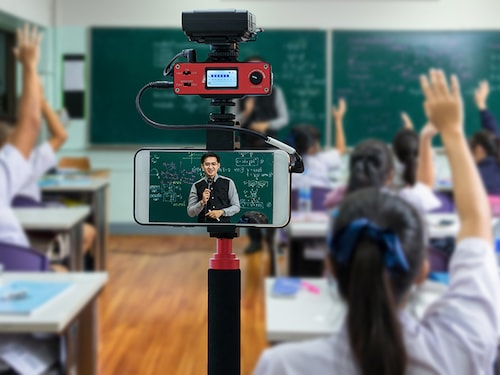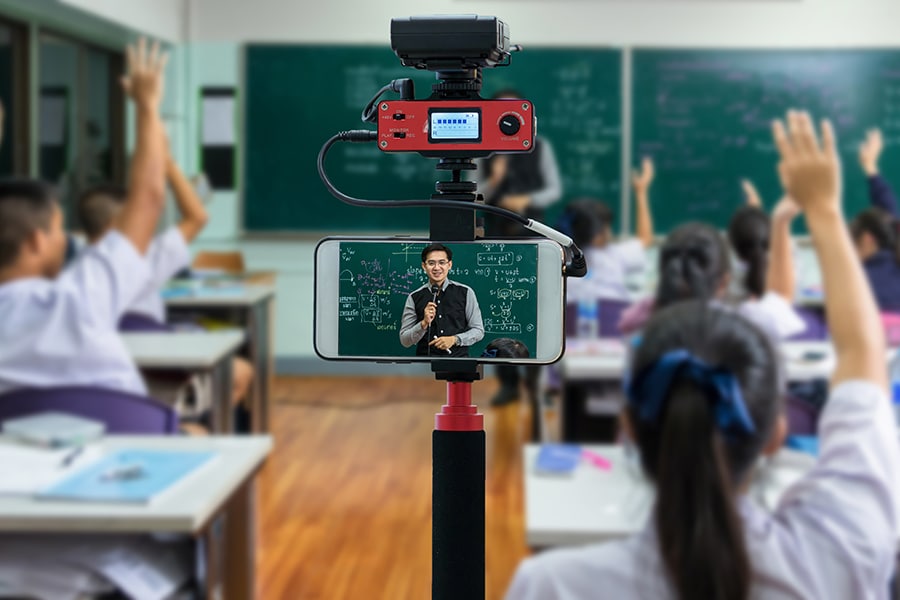ICT education stakeholders need to move from technology provision to technology
Technology can improve learning levels only when it is deliberately integrated with current pedagogical practice


Image: Shutterstock
Information and Communication Technologies (ICT) is being increasingly seen as a panacea for the ‘learning crisis’ affecting public schooling. Massive investments are underway (estimates presented to the 15th Finance Commission are about Rs 56,000 crore during 2021-22 to 2025-26 for school education alone). Most of this investment will be in infrastructure. However, in order to realise the purpose of using ICT—improved learning—we need to pay more attention to how technology gets used by teachers to support a variety of pedagogical methods. That is, we must see technology as only one element in a complex web of interactions among educational, cultural, and institutional practices that determine learning. Introducing ICT is not just a matter of providing hardware and some software. Equally important is facilitating the manner in which it is integrated into this web of interactions. Unfortunately, public educational systems do not seem to be paying enough attention to this element of ICT deployment. True, teachers are being trained in the ‘use’ of technology, but that is the problem—the focus is on operating a system or implementing a learning ‘package’ that has been provided. If public systems have to take technology integration seriously, what do they need to do?
We draw on a recent study of a smart-class initiative that was introduced in September 2017 in 1609 government schools to identify some of the steps that governments need to take. The study covered 2574 Grade-8 children drawn from 155 smart-class and 155 non-smart-class schools, and compared the academic and non-academic (such as self-efficacy) outcomes in the two groups, after controlling for prior academic achievement, student background factors, availability of reading material at home, and private tuitions. The outcomes assessment employed a two-level multivariate analysis to account for children being nested in schools. When we did not find a significant difference in student cognitive and non-cognitive outcomes between the two groups, we dug deeper for the reasons through a series of case studies and interviews. These reasons highlight two lessons that governments need to keep in mind when reorienting themselves from technology provision to technology integration.
First, the process of content development has to also worry about the values and beliefs that might get communicated and how these might interact with teachers’ beliefs. Why is this important? Teachers’ beliefs about learning and teaching crucially determine how teachers receive and integrate technology. A ‘package’ that is not carefully prepared might have two consequences. It might end up supporting some traditional non-productive beliefs of teachers. This was most evident in our study when some elements of the material, that involved some repetition, were interpreted as supportive of rote learning. Another example is provided by content that reinforces the importance of ‘knowing content’—features of a textbook culture are replicated through extensive reliance on pdfs. Even an attempt at gamification results in a devaluation of the process of learning while reinforcing the importance of getting the right answer why an answer is wrong does not matter to the teacher. Or, it might pose a challenge to some beliefs which is addressed through a process of co-optation. For example, some elements of gamification and some activity-centred learning demanded a greater role for learner-centred approaches and student autonomy. However, this can be resisted by, for instance, one-way conversational performances of the teacher substituting for dialogue, or by adopting an “implementer role"—allowing the features of the curriculum package to substitute for teacher input. In both cases, the reproduction of the traditional classroom that results does not mean significantly better learning outcomes.
Governments are constrained by the lack of capacity and capability within for content development and have come to rely on private vendors, not just for the hardware but also for the software. Given this constraint, content development has to be a broad-based consultative process, partnering the vendor with knowledgeable teachers, academics and nongovernmental agencies dealing with ICT in education. It is easy for vendors to rely on a series of pdf documents and accompanying audio-visuals with some gamification thrown in. Nobody questions them on why the interactive potential of technology, or ways of promoting personalised learning, are not being built in. Governments need to work on their own technical capabilities, if only to demand better service from the vendors they rely on.
The second important lesson that a public system needs to keep in mind is to avoid the tempting notion that ‘teacher-proofing’ content is the way to improve outcomes. As one content developer put it, “The teacher does not have to do anything. He just has to implement the package." This ‘package’ positions the teacher as an implementer, very often resulting in the teacher switching on the ‘package’ for the students to follow and downplaying critical teaching functions such as explaining, discussing and answering queries. Students would certainly find the content entertaining, but how much learning happens is open to question. Rather, positioning the teacher as an active agent who is expected to work the technology into her pedagogical plans, and developing the necessary training inputs or programs that can reach large numbers of teachers, are two important tasks for the training establishment. Our systems certainly need to do a lot more on this front. Put in simple words, the two lessons discussed here mean that governments need to seriously shift their outlook from technology provision to technology integration if the investments in technology are to result in better academic outcomes.
Vijaya Sherry Chand is professor at the Ravi J. Matthai Centre for Educational Innovation, IIM Ahmedabad
First Published: Oct 11, 2021, 16:08
Subscribe Now Introducing ICT is not just a matter of providing hardware and some software. Equally important is facilitating the manner in which it is integrated into this web of interactions.
Introducing ICT is not just a matter of providing hardware and some software. Equally important is facilitating the manner in which it is integrated into this web of interactions.